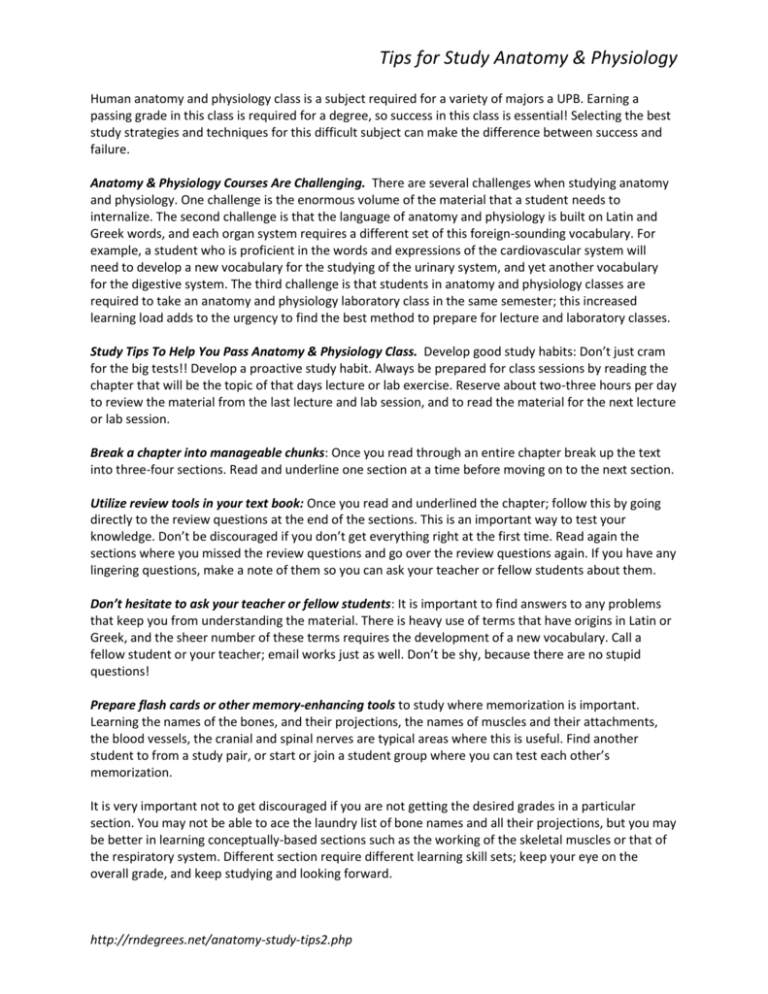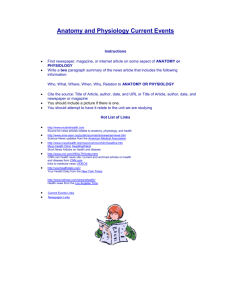Tips for Study Anatomy & Physiology
advertisement

Tips for Study Anatomy & Physiology Human anatomy and physiology class is a subject required for a variety of majors a UPB. Earning a passing grade in this class is required for a degree, so success in this class is essential! Selecting the best study strategies and techniques for this difficult subject can make the difference between success and failure. Anatomy & Physiology Courses Are Challenging. There are several challenges when studying anatomy and physiology. One challenge is the enormous volume of the material that a student needs to internalize. The second challenge is that the language of anatomy and physiology is built on Latin and Greek words, and each organ system requires a different set of this foreign-sounding vocabulary. For example, a student who is proficient in the words and expressions of the cardiovascular system will need to develop a new vocabulary for the studying of the urinary system, and yet another vocabulary for the digestive system. The third challenge is that students in anatomy and physiology classes are required to take an anatomy and physiology laboratory class in the same semester; this increased learning load adds to the urgency to find the best method to prepare for lecture and laboratory classes. Study Tips To Help You Pass Anatomy & Physiology Class. Develop good study habits: Don’t just cram for the big tests!! Develop a proactive study habit. Always be prepared for class sessions by reading the chapter that will be the topic of that days lecture or lab exercise. Reserve about two-three hours per day to review the material from the last lecture and lab session, and to read the material for the next lecture or lab session. Break a chapter into manageable chunks: Once you read through an entire chapter break up the text into three-four sections. Read and underline one section at a time before moving on to the next section. Utilize review tools in your text book: Once you read and underlined the chapter; follow this by going directly to the review questions at the end of the sections. This is an important way to test your knowledge. Don’t be discouraged if you don’t get everything right at the first time. Read again the sections where you missed the review questions and go over the review questions again. If you have any lingering questions, make a note of them so you can ask your teacher or fellow students about them. Don’t hesitate to ask your teacher or fellow students: It is important to find answers to any problems that keep you from understanding the material. There is heavy use of terms that have origins in Latin or Greek, and the sheer number of these terms requires the development of a new vocabulary. Call a fellow student or your teacher; email works just as well. Don’t be shy, because there are no stupid questions! Prepare flash cards or other memory-enhancing tools to study where memorization is important. Learning the names of the bones, and their projections, the names of muscles and their attachments, the blood vessels, the cranial and spinal nerves are typical areas where this is useful. Find another student to from a study pair, or start or join a student group where you can test each other’s memorization. It is very important not to get discouraged if you are not getting the desired grades in a particular section. You may not be able to ace the laundry list of bone names and all their projections, but you may be better in learning conceptually-based sections such as the working of the skeletal muscles or that of the respiratory system. Different section require different learning skill sets; keep your eye on the overall grade, and keep studying and looking forward. http://rndegrees.net/anatomy-study-tips2.php






